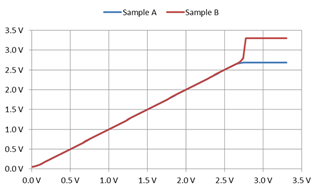Other Parts Discussed in Thread: TLV9052, LM358
Hi Experts,
We would like to ask assistance on this query about TLV2772A output behavior when input signal is outside recommended level.
From the datasheet, recommended Vdd is 2.5 to 6V. Cx would like to operate it with 3.3Vdd.
Question:
[1] What would happen to the output if the input signal is greater than (Vdd - 1.3)volts? Will it reduce the output by 1.3V?
[2] Datasheet shows it's a rail-to-rail but why does maximum input signal is limited to (Vdd-1.3V)?

Please enlighten us. Thank you.
Regards.
Archie A.


